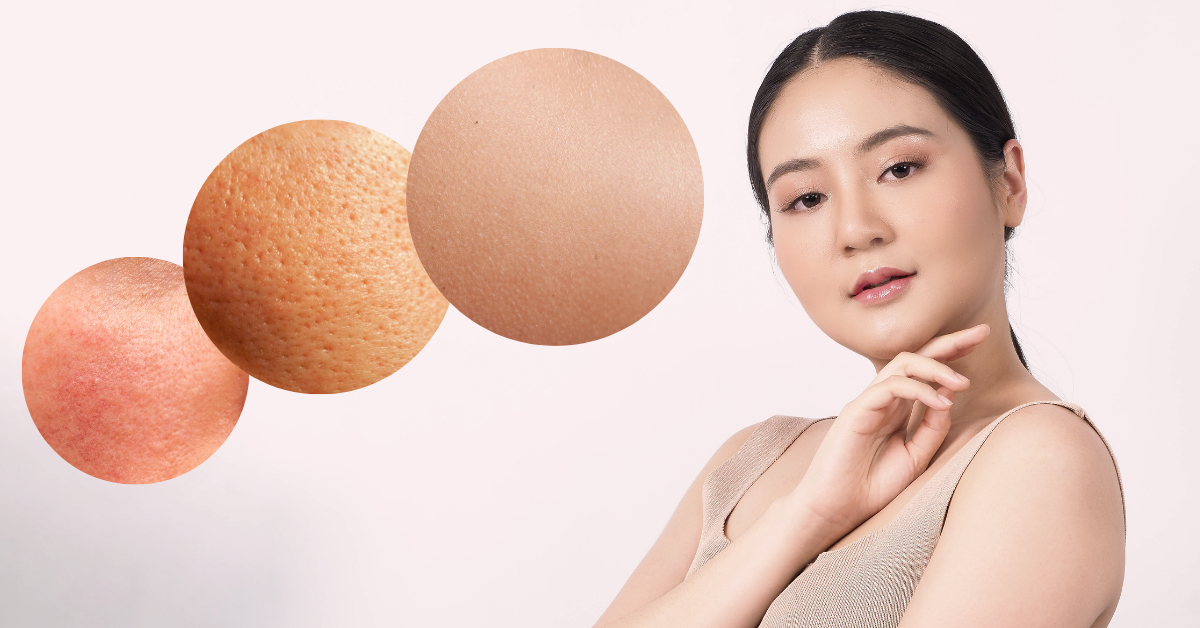Does each component affect each skin type differently? National brand goods may not be ideal for your skin! Skincare requires recognizing your specific skin type.
Table of Contents
ToggleWhat Are The Different Types Of Skin?
You should know which of the four skin types you have so you can take better care of your skin. Find out what kind of skin you have by reading on!
Normal Skin-type
You are very lucky to have a good skin. It would have thick, beautiful skin that ages beautifully and doesn’t age too quickly. Care for it is easy, and it doesn’t have many problems. Regular use of a face cleaner like Neutrogena’s Deep Clean face cleaner and a moisturizer will keep it soft and safe.
How can you identify normal skin?
- Smooth texture
- Fine pores
- No sensitivity
- No blemishes
- Few or no breakouts
- Radiant complexion
Dry Skin-Type
Skin that isn’t getting enough water makes less oil and is dead. Usually has clear lines around the eyes and mouth. This skin is easily hurt by cold and dry air. People with dry skin should get lots of water and, if necessary, vitamins. You can use Neutrogena’s Deep Clean refreshing wash every day to wake up your skin. To keep skin fresh and hydrated, you should use a soothing cream made for dull and dry skin every morning and night.
How can you identify dry skin?
- Flaky and rough skin
- Uneven texture
- Itching
- Skin feels tight
- More visible lines
- Less elasticity in skin
Oily/acne prone Skin-Type
This skin is shiny, sweaty, and prone to redness, acne, blackheads, and open pores because it makes too much oil. When you wake up and go to sleep, you need an oil-free face wash. Neutrogena’s Free of oil acne spots Wash Facial Cleanser gets rid of pimples and stops it from coming back. Grapefruit is added to make it look better. Neutrogena Ultra Sheer sunscreen keeps oily skin from getting burned. It doesn’t leave your face feeling heavy and is gentle on it.
How can you identify oily skin?
- Greasy appearance
- Open/Big pores
- Prone to breakouts
- Blackheads, other blemishes, etc.
Combination Skin-Type
This type has normal skin, but the T-zone is oily. Because this skin type is oilier and more sensitive to the sun, it needs to be protected from it. A gentle wash is needed to clean cells deeply. Use Visibly Clear in the morning and at night and Ultra Sheer sunscreen if you have mixed skin.
How can you identify combination skin?
a. Oily T-zone and dry cheeks
b. Breakouts only on forehead, chin and nose
c. Sensitive cheeks
d. Large, open pores
e. Shiny skin
Basics Of SkinCare

- Protect your skin from UVA and UVB rays by always using a broad-spectrum sunscreen.
- Make sure you drink enough water.
- Always wash your face gently. Don’t use too much makeup or items with strong chemicals.
- It is important to moisturize your skin on a regular basis.
Remember that you need to get your skin tested by a doctor to be sure of your skin type and know which skincare products will work best for it.
Skincare Routine Basics for All Skin Types
No matter what kind of skin you have, everyone should do certain things every day to take care of their face. Here are the main points:
Cleanse
A gentle cleanser is the first step in your process. Cleaning your face gets rid of dirt, oil, and makeup, but be careful not to take too many of your skin’s natural oils. To keep things in order, look for cleansers that are made for your skin type.
Tone
A toner gets rid of any dirt or oil that’s still on your skin after washing and gets it ready for the next step. It helps oily and mixed skin types control shine the most, but make sure to pick a formula without alcohol to keep your skin from getting irritated.
Moisturize
Yes, even skin that is sticky needs water! Getting the right recipe is important. Creams that are thicker are better for dry skin, while moisturizers that are light and gel-based are better for oily or mixed skin. Putting moisturizer on your face helps it stay protected and hydrated.
Protect with SPF
No matter what kind of skin you have, you have to use sunscreen every day. UV rays can make you age faster and raise your risk of getting skin cancer. Choose one with an SPF of 30 or more, and if you’re going to be outside all day, don’t forget to reapply it.
Common Mistakes in Skincare and How to Avoid Them

Even with the best intentions, it’s easy to make mistakes when caring for your skin. Here are a few common missteps and how to avoid them:
Over-Cleansing
Cleansing too often can strip your skin of its natural oils, leading to dryness and irritation. Stick to cleansing twice a day, and choose a gentle formula that won’t damage your skin barrier.
Skipping Sunscreen
Some people think they don’t need sunscreen if they’re indoors or if it’s cloudy. This is a big mistake! UV rays can still penetrate through windows, and clouds don’t block them entirely. Make sunscreen part of your daily routine, no matter the weather.
Using Harsh Products
Some products can be too aggressive, especially for sensitive or dry skin. Avoid anything with alcohol, synthetic fragrances, or too many exfoliating acids. Opt for gentler, more natural alternatives.
Conclusion
It doesn’t matter what kind of skin you have; the key to a healthy glow is stability and knowing what your skin needs. Do not make the same mistakes other people do, use natural skin care products that are made for your skin type, and most importantly, pay attention to what your skin is telling you. Even though everyone’s skin is different, if you follow the right steps and use the right products, you can get healthy, glowing skin.
FAQs
Sunscreen protects against UV damage, which can lead to premature aging and skin cancer. It’s crucial for every skin type, even on cloudy days or when indoors.
If you have sensitive skin, avoid products with alcohol, synthetic fragrances, and harsh exfoliants. Stick to gentle, calming ingredients like chamomile or aloe vera.
To determine your skin type, wash your face and wait an hour. If your skin feels oily, you likely have oily skin. If it feels tight or flaky, you may have dry skin. If only certain areas are oily, you have combination skin.

